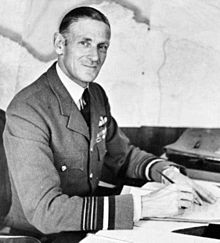Sir Keith Park | |
|---|---|
 | |
| Nickname(s) | "The Defender of London" "Skipper" |
| Born | 15 June 1892 Thames, New Zealand |
| Died | 6 February 1975 (aged 82) Auckland, New Zealand |
| Allegiance | New Zealand (1911–15) United Kingdom (1915–46) |
| Service | New Zealand Military Forces (1911–15) British Army (1915–18) Royal Air Force (1918–46) |
| Years of service | 1911–1946 |
| Rank | Air Chief Marshal |
| Commands | Air Command, South East Asia (1945–46) Middle East Command (1944–45) AHQ Malta (1942–44) AHQ Egypt (1942) No. 23 (Training) Group (1940–42) No. 11 (Fighter) Group (1940) RAF Tangmere (1937–38) RAF Northolt (1931–32) No. 111 Squadron (1927–28) No. 48 Squadron (1918–19) |
| Battles / wars | |
| Awards | Knight Grand Cross of the Order of the Bath Knight Commander of the Order of the British Empire Military Cross & Bar Distinguished Flying Cross Croix de guerre (France) Commander of the Legion of Merit (United States) |
| Other work | City Councillor, New Zealand |
Air Chief Marshal Sir Keith Rodney Park, GCB, KBE, MC & Bar, DFC (15 June 1892 – 6 February 1975) was a New Zealand-born officer of the Royal Air Force (RAF). During the Second World War, his leadership of the RAF's No. 11 Group was pivotal to the defeat of the Luftwaffe in the Battle of Britain.
Born in Thames, Park was a mariner when he enlisted in the New Zealand Expeditionary Force for service in the First World War. Posted to the artillery, he fought in the Gallipoli campaign, during which he transferred to the British Army. On the Western Front, he was present for the Battle of the Somme and was wounded. He obtained another transfer, this time to the Royal Flying Corps. Once his flight training was completed, he served as an instructor before being posted to No. 48 Squadron on the Western Front. He became a flying ace, achieving several aerial victories and eventually commanding the squadron.
In the interwar period, Park served with the RAF in a series of command and staff postings, including a period as air attaché in South America. By the late 1930s, he was serving in Fighter Command, as Air Marshal Hugh Dowding's senior air staff officer. The two worked to devise tactics and management strategies for the air defence of the United Kingdom. Soon after the outbreak of the Second World War, Park was given command of No. 11 Group, responsible for the defence of South East England and London. Owing to its strategic significance and geographic location in relation to the Luftwaffe, No. 11 Group bore the brunt of the German aerial assault during the Battle of Britain. Park's management of his fighter aircraft and pilots helped ensure that Britain retained air superiority along the English Channel.
Relieved of command after the Battle of Britain, Park served in a training role before being posted to the Middle East as Air Officer Commanding, Egypt, in late 1941. Midway through the following year, he took charge of the aerial defences of Malta, then under heavy attack from the Luftwaffe and the Regia Aeronautica (Italian Air Force). When the siege was lifted Park transitioned Malta's RAF forces from a defensive role into an offensive footing in preparation for the Allied invasion of Sicily. From 1944, he held senior roles in the Middle East and in British India. He retired from the RAF in 1946 as an air chief marshal. Returning to New Zealand, he worked in the aviation industry for a British aircraft manufacturer and then became involved in local body politics in Auckland. He died from heart problems in February 1975.